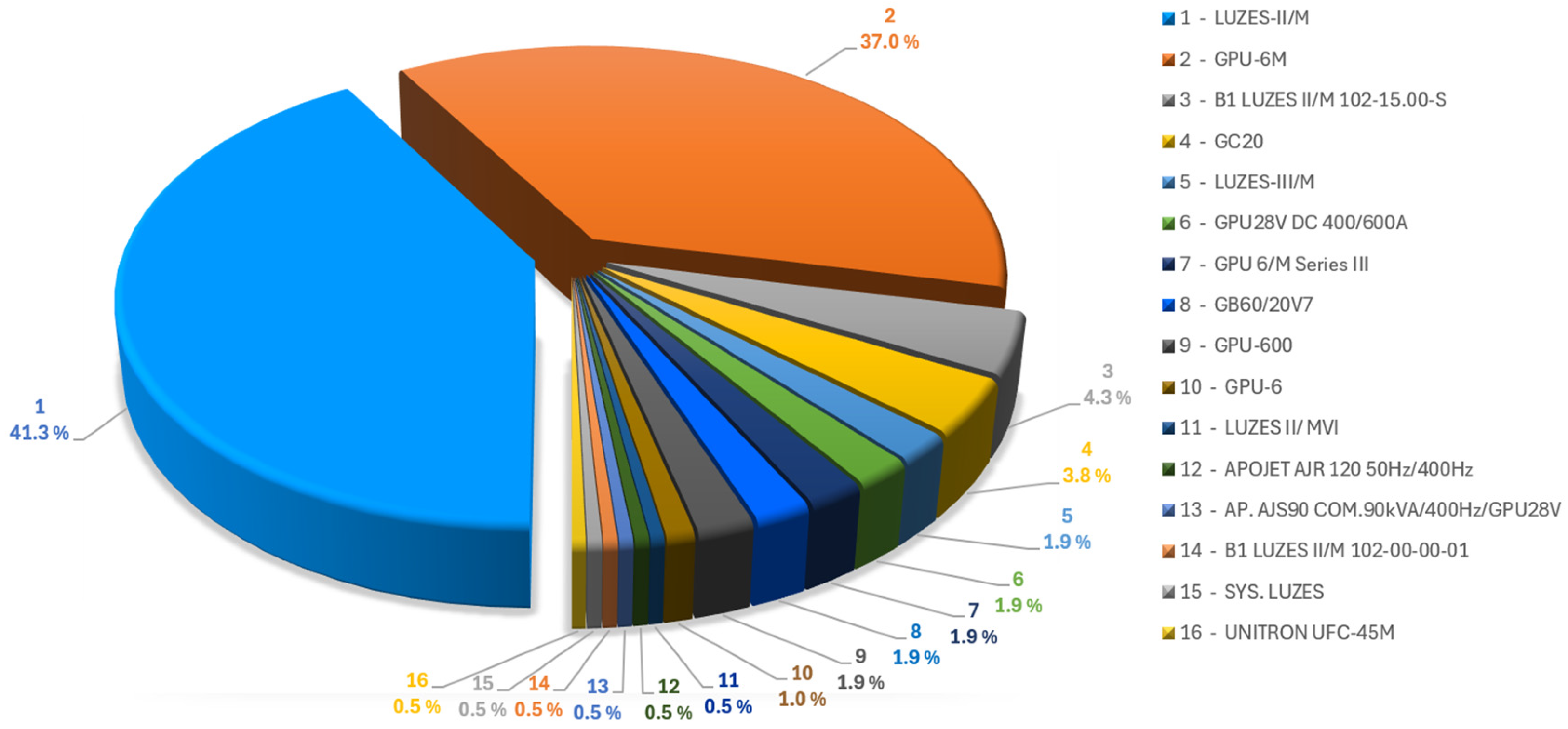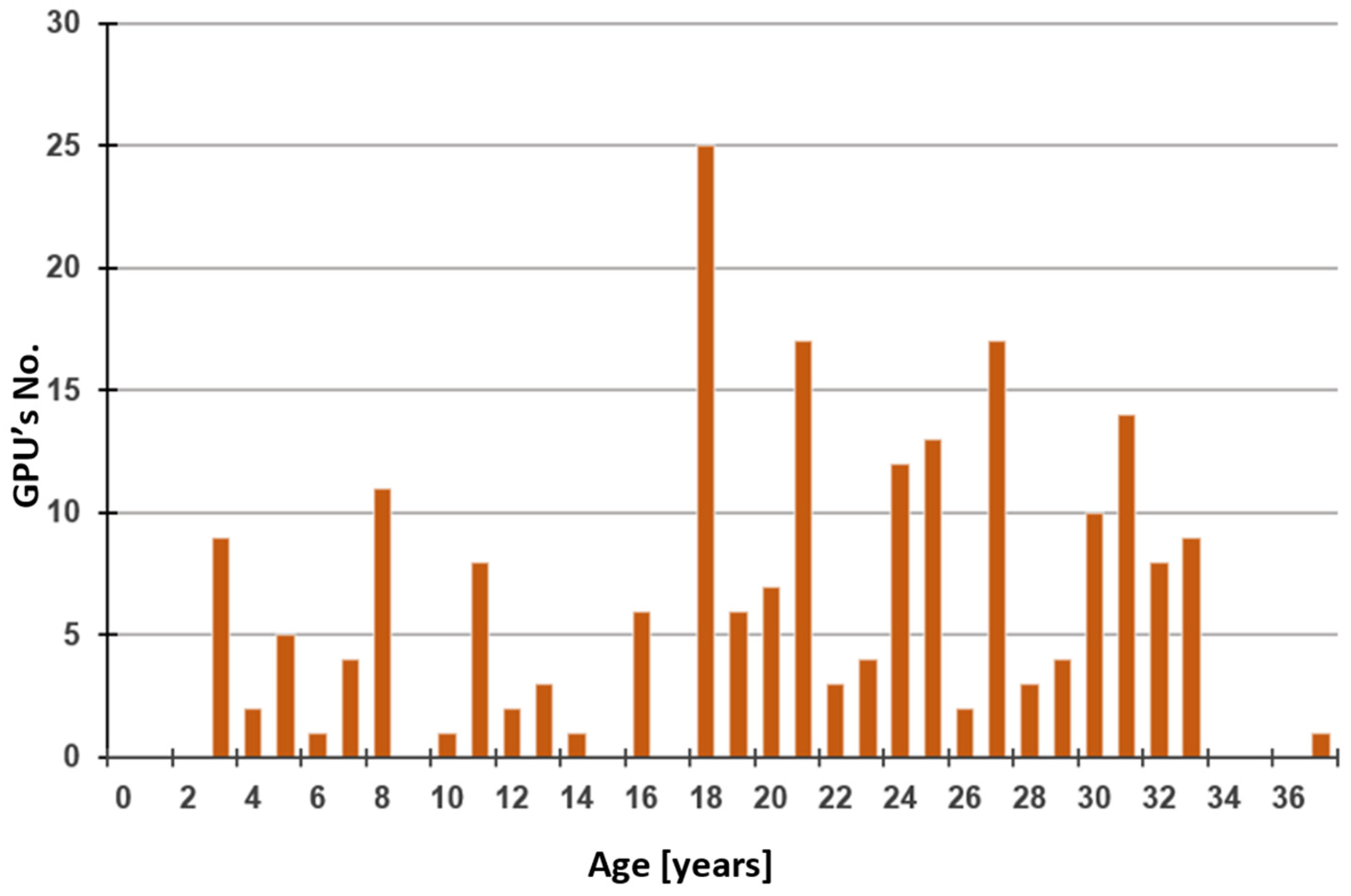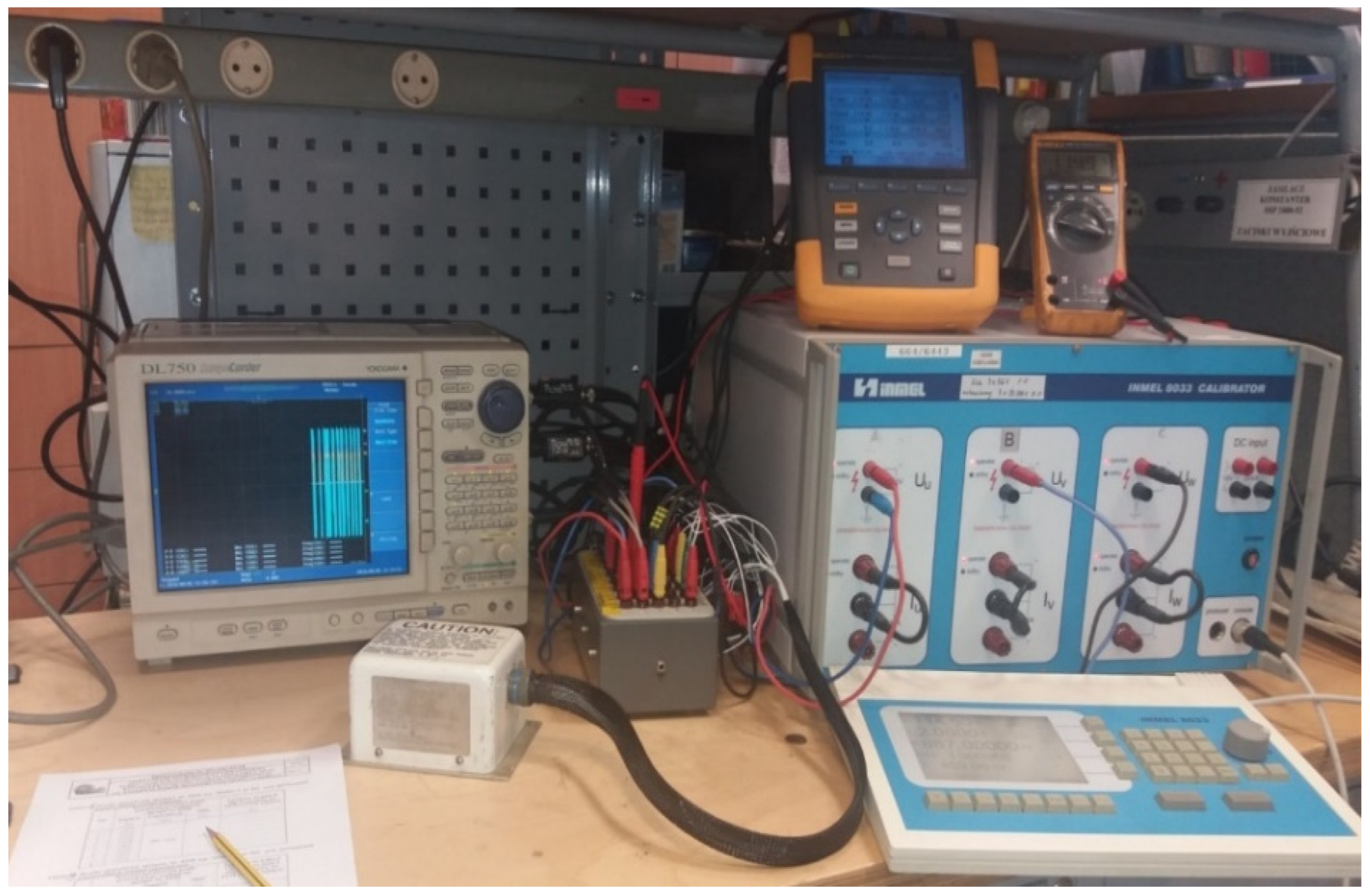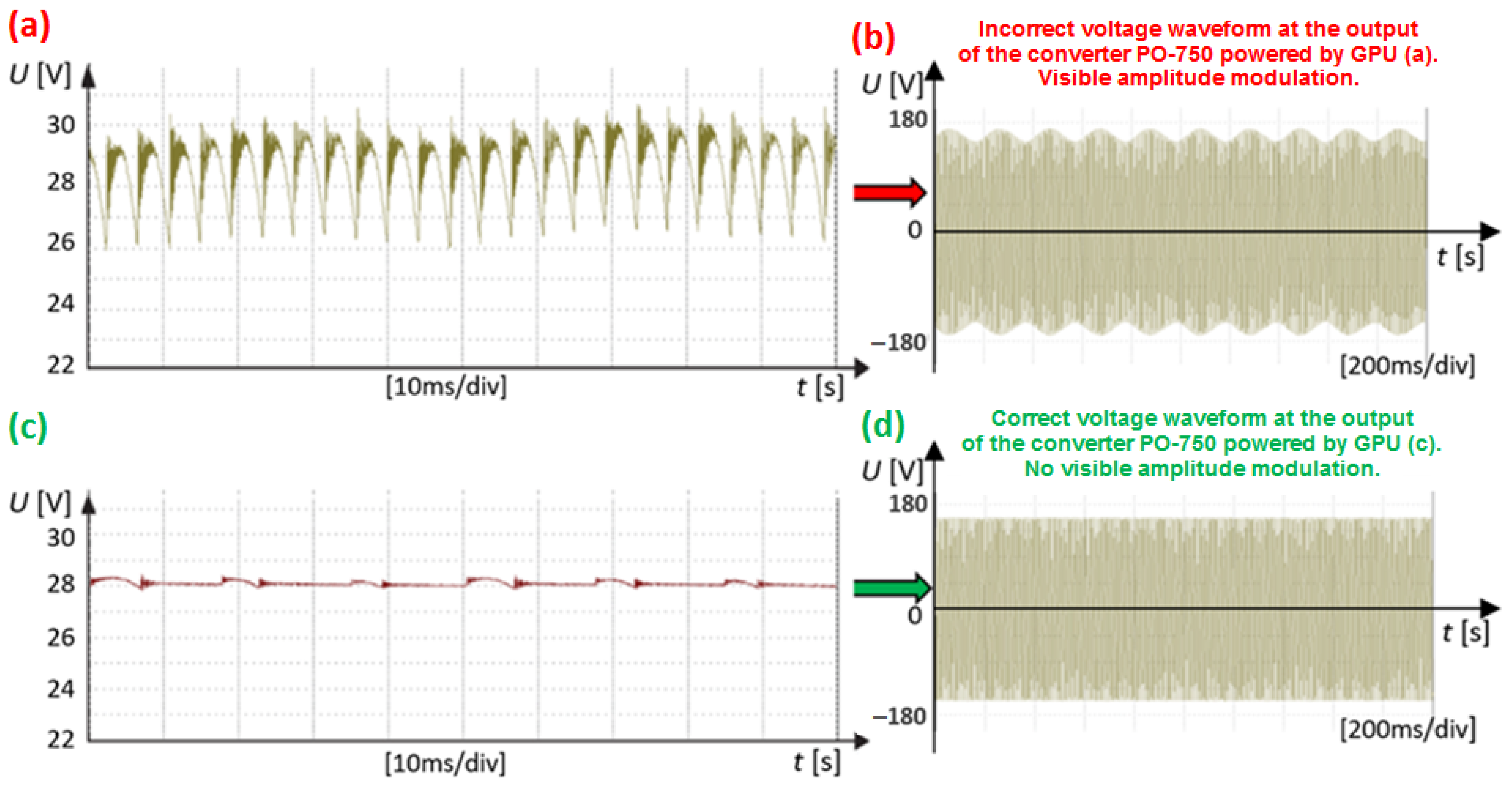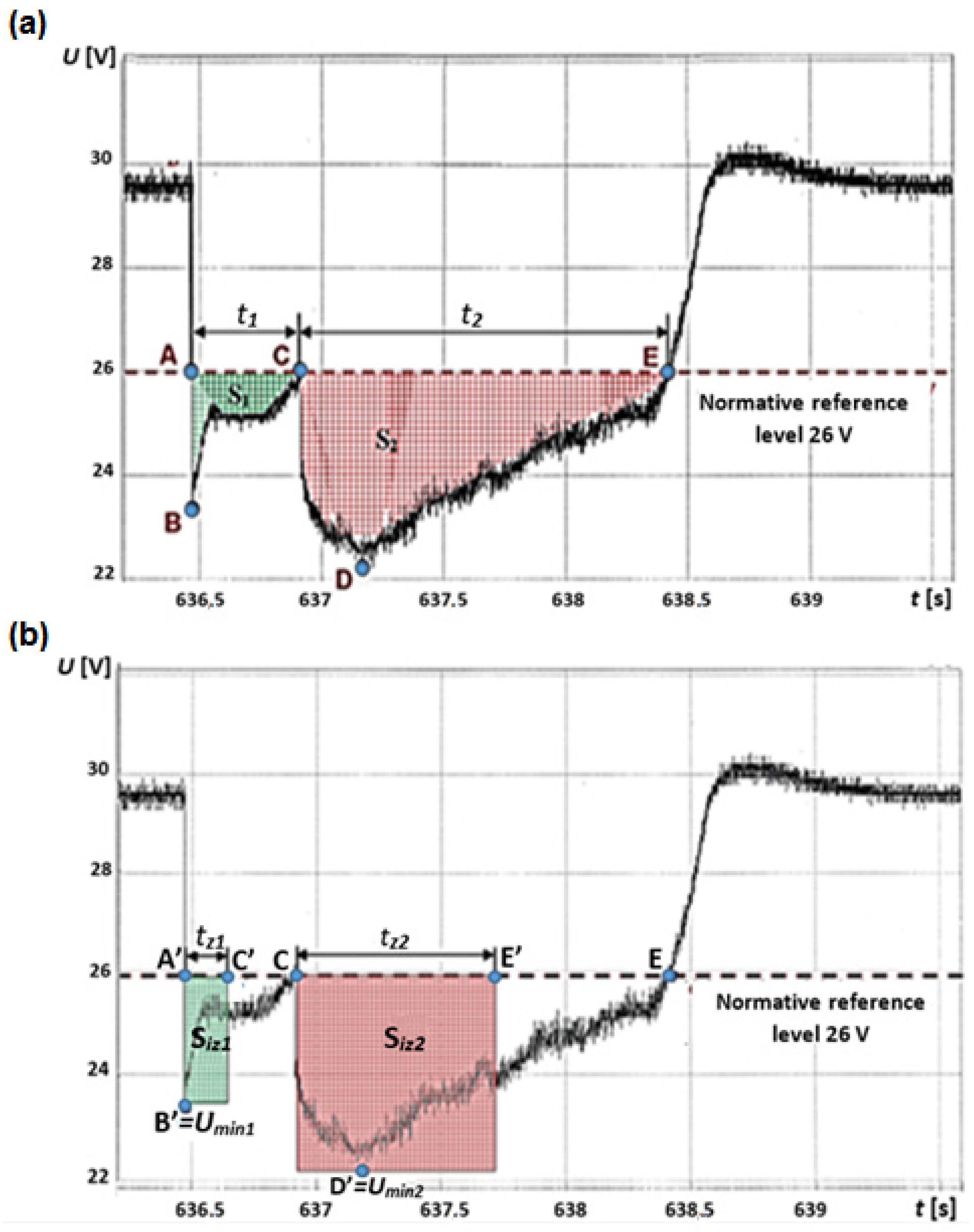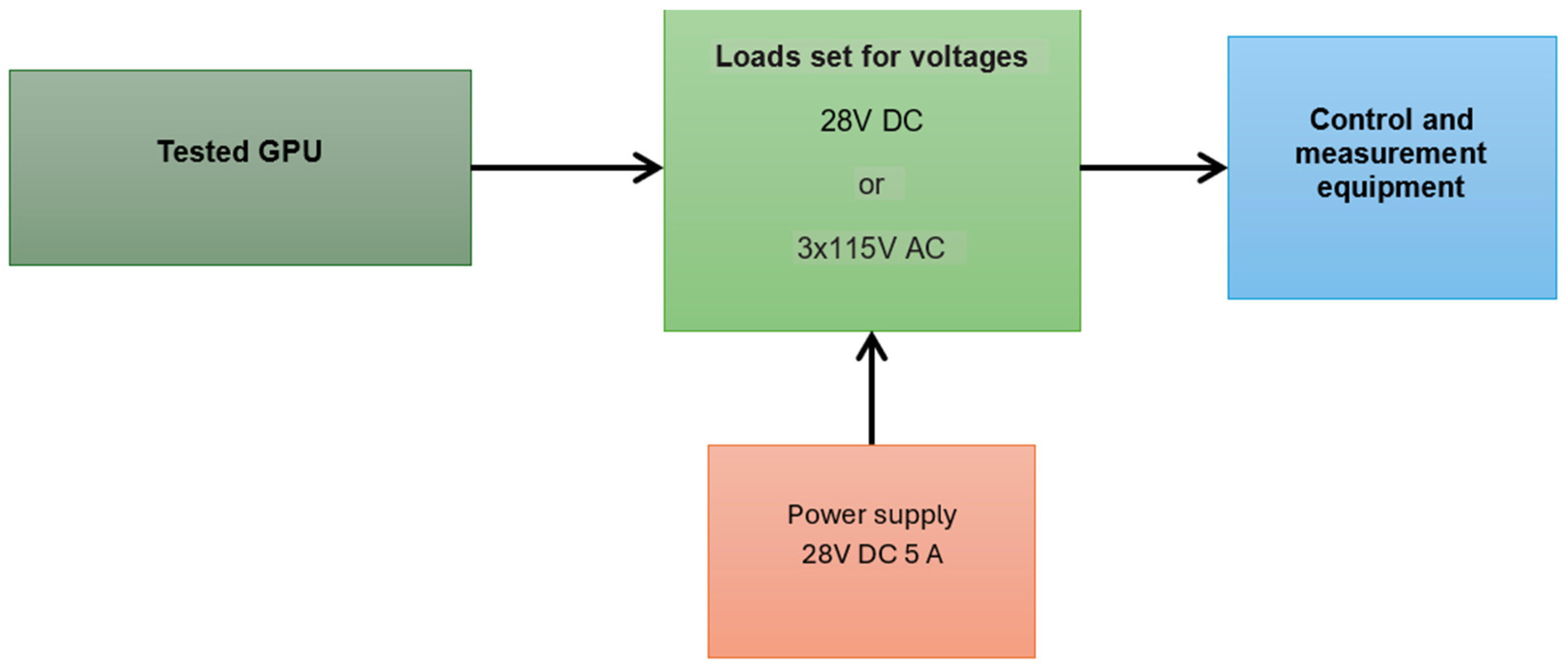1. Introduction
One of the key factors directly influencing the efficiency of the operational process of any technical object, including an aircraft (A/C), is its readiness. This factor is not solely related to the properties and characteristics of a specific type of aircraft but also to its operating system, the systems cooperating with it, and the surrounding environment. When aircraft are on the ground, not using internal power sources, external ground power units (GPUs) are used to provide electrical power to their systems. Both military and civilian aircraft require a high-performance and reliable GPU to ensure safe operation under various environmental conditions. The quality of the power supplied by the GPU has a significant impact on the reliability, as well as the costs and safety of aircraft operations. The technological advancement of aircraft has made their operation increasingly resource-intensive, demanding a wide array of support to ensure they are used with optimal efficiency and safety. This safety is defined by the aircraft’s continuous airworthiness management and the assurance of high operational reliability, both of which are closely linked to effective ground maintenance with GPU utilization.
The presented analysis is the first of its kind prepared in the Polish Armed Forces (PAF), and indicates that currently, they employ a variety of ground power supply sources for aircraft maintenance and operations. Many of these power sources have been in use for several years, and statistics from the airworthiness management system [
1] have recorded numerous aircraft defects or failures related to the operation of GPU. Therefore, ongoing assessment of the quality of power supplied by GPU is crucial for ensuring proper aircraft operation [
2,
3]. Poor quality of electrical power from GPU, especially during transient states (such as overvoltage pulses, peak pulses, undervoltage pulses or instability), can pose a serious threat to modern onboard systems, which rely on sensitive electronic and microprocessor systems. Additionally, incorrect power parameters during stable states can severely affect the reliability of checks and adjustments performed during aircraft maintenance, potentially leading to erroneous or incomplete execution, posing a serious risk to operational safety, flight security, and mission execution. Therefore, aircraft manufacturers often recommend the use of GPU from authorized suppliers, which increases operational costs and prevents the use of existing ground power sources.
2. Problem Basis
Supervision over the aircraft operation encompasses all aspects related to safety, including adherence to aircraft operation and airworthiness, as well as the maintenance of other aviation equipment regulations, the use of airfields and ground aviation facilities, aircraft ground support equipment, maintaining the qualifications and certifications of aviation personnel, and adherence to air traffic rules and regulations. In accordance with Polish Military regulations, operation refers to a set of purposeful organizational, technical, and economic activities carried out by personnel in relation to the aviation technology equipment, as well as the mutual relationships between them, starting from the moment the aircraft is put into service according to its intended purpose until its disposal [
4,
5]. Aircraft operation is conducted through the primary process of in-flight use, airworthiness management, as well as readiness. The course of aircraft operation involves planned activities resulting from the need to perform tasks designated for a particular type of aircraft, which is necessary to maintain its readiness while taking into account the physical infrastructure (tools, facilities, personnel, supplies), which are key factors determining operational readiness. The accomplishment of tasks in aviation systems is achieved through compatibility and synchronization of various technical resources interacting with the aircraft in a specified order and within the designated time frame [
5].
The operational system significantly influences the reliability and readiness of the aircraft, the safety of flights, and the completion of missions within the designated time frame. While individual components of aviation operation support systems generally do not directly affect the technical readiness of aircraft, in specific cases, they can lead to a reduction in readiness.
This occurs when these components cause failures or defects to the aircraft, often due to errors in the operation of personnel or improper functioning of the technical equipment. Regardless of working conditions, the electrical power supplied by GPU should not negatively affect the aircraft’s electrical system or cause discrepancies [
2,
3]. One contributing factor to an aircraft becoming unairworthy is the poor quality of electrical power supplied by GPUs, which can have a significant impact on the safety of its operation.
3. Research Object
GPUs are part of an aircraft’s Ground Support Equipment (GSE). Within the inventory of the PAF, there are 28 types of GPUs, including fixed or portable units, which comprise 53% of the total, and vehicle mounted or towable units, which constitute 47%.
The PAF utilize 16 types of fixed or portable GPUs. A detailed list of these GPUs in service is presented in
Table 1.
The LUZES-II/M and GPU-6M GPUs are the most numerous groups. Single units of other GPU types, other than those mentioned in
Table 1, are also operated in the PAF. The percentage distribution of each GPU type is shown in
Figure 1.
Table 2 presents a list of 12 types of vehicle-mounted or towable GPU units operated by the PAF.
The most common in this group are the APA-5D and LUZES V/D GPUs mounted on a JELCZ 442.32 and STAR-944 chassis. Among the 12 types of currently operated vehicle-mounted or towable GPUs, these three models make up 65% of the PAF equipment. There are also single units, other than those mentioned in
Table 2, of these types of GPUs operated within the PAF. The percentage distribution of different types of vehicle-mounted or towable GPUs used by the PAF is shown in
Figure 2.
Considering only the type of vehicle-mounted or towable GPUs (regardless of its transport platform), their numerical distribution is shown in
Table 3, with the percentage breakdown illustrated in
Figure 3. It can be observed that LUZES V comprises a substantial 71% of the inventory of the PAF, followed by APA 5D units at 23.5%, with the remaining 5.5% consisting of other GPU types.
A significant factor for GPUs in use is its operational age. The aging processes that occur during the lifecycle can substantially contribute to the deterioration of the technical condition of the GPUs in use, thereby affecting the power quality they produce. The age of fixed and portable GPUs in the PAF is illustrated in
Figure 4. The oldest operational GPU for this group is 37 years (one LUZES-II/M), while eight GPU-6M units have been in service for 33 years. The LUZES-II/M and GPU-6M type units also belong to the youngest group of fixed and portable GPUs used in the PAF. Additionally, in recent years, other types of GPUs have been introduced into service, including: GPU28V DC 400/600A, APOJET AJR 120 50 Hz/400 Hz, AP. AJS90 COM.90 kVA/400 Hz/GPU28V, GC20, GB60/20V7, UNITRON UFC-45M, and GPU-600.
The age of vehicle-mounted and towable GPUs is shown in
Figure 5. It should be observed that the older operational GPUs reach as much as 42 years.
Three groups of GPUs can be identified based on their age:
First Group—ranges from 1 year to 13 years
Second Group—ranges from 19 to 29 years
Third Group—ranges from 34 to 42 years
The last group consists of 48 units, among which three of them have been in service for an impressive 42 years—one APA-5D and two LUZES V/D units mounted on the STAR 266M2 chassis.
The first age group of GPUs include, among others, the P70TA000A03-801, HOBART 4400, and LUZES-V/N, as well as LUZES V/D mounted on the JELCZ 442.32 chassis.
3.1. Statistics on Aircraft Defects Related to GPUs
During the operation of military aircraft, defects have occurred due to poor power quality or GPU failures. From 2014 to 2023, the airworthiness management IT system [
1] recorded seventy-two defects or failures related to GPUs, which resulted in the aircraft being rendered unairworthy. The number of these events over the subsequent years is illustrated in
Figure 6.
Figure 7 presents the number of defects and failures related to GPUs in relation to specific A/C types.
The highest number of defects or failures on the W-3WA type associated with the GPUs, shown in
Figure 7, is probably due to the large population in the PAF of this type of helicopter and the high current draw from the power supply during start-up of this aircraft, which is a high requirement for power quality. Engine starting on the W-3WA helicopter is performed using an electric starter mounted directly on the engine gearbox.
3.2. Examples of Consequences of the GPU Improper Operation
The non-compliance of power quality [
3] or GPU defects have led to the unairworthiness of various aircraft, including the following cases:
Incorrect assessment of AC EPM unit operation on SH-2G helicopters, resulting in unnecessary unit withdrawals from service.
Non-compliant power quality of observed onboard converters used during the ground checks of aircraft systems, e.g., radio navigation devices.
Illumination and extinguishing of the GPU button during the CASA C 295M engine start.
Loss of indications for engine parameters and circuit breakers tripped during the startup of the W-3WA helicopter.
Inability to power up the PZL-130TC-II aircraft.
Disconnection of the GP-21 GPU during the MiG-29M aircraft engine start.
Voltage fluctuations in the AC (Alternating Current) power supply in the onboard power supply system of the M28B aircraft.
The presented examples confirmed findings from studies conducted by the AFIT (Air Force Institute of Technology) regarding the incorrect assessment of AC EPM unit performance on SH-2G helicopters [
6]. The investigations were carried out using a test setup for the AC EPM unit M24021-4 type or M24021-5 type from the SH-2G helicopter, as depicted in
Figure 8.
The studies revealed that the AC EPM helicopter units declared as faulty were fully operational; however, the power quality from the GPU (used as a power source for the aircraft) did not meet the requirements [
3]. This discrepancy led to the unit being taken out of service and the aircraft being unairworthy.
The next presented example was caused by a seemingly minor parameter: the ripple of the direct current voltage at the GPU output (
Figure 9a). It turned out that this parameter significantly affects the performance of the converter, leading to noticeable amplitude modulation of the converter’s output voltage (
Figure 9b). The distorted voltage from the converter negatively impacts the operation of onboard devices during aircraft maintenance and affects the reliability of checks and adjustments. In contrast,
Figure 9c shows the correct waveform of the direct current voltage at the GPU output, while
Figure 9d illustrates the output voltage of the converter.
Poor power quality supplied from the GPU to A/C, particularly during transients (such as overvoltage pulses, peak pulses, undervoltage pulses, and voltage instability) poses a significant risk to modern on-board systems that utilize sensitive electronic and microprocessor-based circuits [
7]. In modern aviation, the reliability of on-board systems increasingly depends on the utilized GPUs [
8,
9,
10].
The power quality supplied to A/C has a significant impact on reliability, operating costs, and safety. Poor parameters of electrical power can disrupt the operation of the A/C on-board systems, lead to shutdowns, or, in extreme cases, cause damage. Apart from constant disruptions related to the load from properly functioning systems and electrical consumers of A/C, intermediate disruptions are also significant. These disruptions can stem from failures within the power distribution system or local electrical installation of the aircraft, as well as high-power consumers, which may result from decreased reliability and durability of switching devices or activation of overcurrent protections due to repeated (long-term) circuit overloads. Sudden changes in power demand, which generate transient states in the power supply system, are particularly critical for the on-board devices and systems.
3.3. Case Study
Figure 10 shows exemplary voltage waveform recorded during A/C startup from the GPU.
Typically, analyzing under- and overvoltage peaks involves calculating the value of the product of the non-standard time and voltages—specifically, the integral of voltage over time.
Figure 11 provides an example of transient voltage analysis over time after a step load is applied to a DC power supply system.
According to Polish military standard [
3], transient voltages are converted into their equivalent replacement peaks, which are rectangular DC voltage pulses at 28 V, matching the actual voltage pulses (
Figure 11a, details: S
1, S
2—undervoltage peaks). The replacement peak pulse S
iz (S
iz2) takes the form of a rectangle with the same area and minimum voltage U
min1 (U
min2), but with a shorter duration (reduced time t
z) than the actual pulse S
1 (S
2)—see
Figure 11b, details: S
iz1, S
iz2.
For the transient state shown in
Figure 11a, the replacement peaks (areas S
1, S
2 below the lower reference level of 26 V) should be calculated according to Formulas (1) and (2).
The reduced time t
z of the replacement peaks should be calculated pursuant to Formula (3).
The parameter determined during the transient state is the value of the product of non-standard time and voltage, which is converted into the so-called replacement peak S
iz according to Formulas (4) and (5).
These calculated pulses, shown as equivalent replacement peaks S
iz in
Figure 11b (a rectangle with sides: height Umin and width t
z), are compared to the normative characteristics of the transient state, and their values should fall within the limits specified in the standard [
3].
Based on the authors’ experience, it can be concluded that long-age operation of GPUs negatively affects the power quality from these sources. This is specifically true during their operation in transient states [
11]. An example of the impact of GPUs’ age on changes in the parameters of DC power in a transient state is presented in
Figure 12, which shows the visualization of test results for the DC power supply source of the Su-22 aircraft in a transient state over successive years in service.
In the subsequent years of the source’s operation, power quality parameters deteriorated until they reached non-compliant values. For this reason, older GPUs should be subjected to particularly careful verification of their technical condition, including the generated power quality, and especially the transient power parameters of the GPU.
Additionally, transient surge voltage loading of the GPU is an essential element for transient testing of 115/200 VAC GPU. Transient tests are performed by measuring the voltage AC at the end of the GPU dispensing cable during load changes, and are carried out analogously to the transient tests of a 28 VDC power circuit. However, in contrast to DC circuits, it is not the voltage waveform that is to be tested as a function of time, but the voltage envelope waveform. The time waveform u = f(t) is analyzed separately.
These peaks are converted into the corresponding equivalent peaks: overvoltage or undervoltage.
The peaks duration, on the other hand, is calculated by integrating the following:
The resulting areas are divided by the amplitude of the peak, i.e.:
The reduced value of the peak duration is thus obtained. The value of the equivalent peak is assimilated to the normative curve [
3]. If at least one of the equivalent pulses of a given GPU channel crosses the normative curve, the test result is negative.
5. Methodology Verification
Power quality tests of GPUs performed by the authors are carried out on the test bench shown in
Figure 13.
The GPU power quality test bench consists of a load set equipped with an aerial connector that allows the plug of the dispensing cable of the GPU under test to be connected. Depending on the type of the GPU under test, the test bench is equipped with a load set for 3 × 115 V AC voltages or a 28 V DC load set (
Figure 13). An external 28 V DC power supply is connected to control the operating contactors of the load set. The control and measurement equipment are connected to the laboratory sockets of the load set.
The control and measurement equipment consists of the following:
DC ammeter→2500 A, 2%
AC ammeter→390 A, 2%
Voltmeter→AC/DC, 400 Hz, 200 V, 1%
Harmonic analyzer→THD, 250 V
Power analyzer→3 phase, 2%
Voltage recorder→8 channels DC/AC 250 V, 4 channels RMS 250 V, 20 ks/s.
Oscilloscope→4 channels 250 V
Frequency recorder→1 channel 400 Hz, 115 V
The comparative results presented below show how the proposed methodology effectively identifies the GPU with different lifetimes in relation to the power quality requirements of the standard [
3]. The comparison presented is for a GPU with the same power rating operated for 4 years (No. 1) and for 20 years (No. 2). Values obtained that do not comply with the requirements of the standard [
3] are written in bold.
Example test results for GPU No. 1 and No. 2 at the end of a 28 V DC dispatch cable in steady state obtained with rated currents of 0% I
z, 5% I
z, and 85% I
z are shown in
Table 4,
Table 5 and
Table 6.
The transient tests of GPU No. 1 and No. 2 were performed by loading the GPU device at the end of a 28 V DC dispensing cable with a current of 5% Iz and then pulse-loading the device with a current of 85% Iz. The 85% Iz current was held for about 5 s and the GPU load was reduced to 5% Iz.
Example results from testing GPU No. 1 and No. 2 at the transient end of the 28 V DC dispensing cable are shown in
Table 7.
The GPU transient tests were carried out by loading the GPU at the end of a 3 × 115 V AC distribution cable with a current of 5% I
z, and then the device was pulse-loaded with a current of 85% I
z. The 85% I
z current was then held for approximately 5 s, and the GPU load was reduced to 5% I
z. Example results for GPU No. 1 and No. 2 at the end of a 3 × 115 V AC distribution cable transient are shown in
Table 14 and
Table 15. Non-conforming values are written in bold.
6. Conclusions
The power quality supplied by the GPU has a significant impact on reliability, costs, and the operation safety of A/C.
The GPUs operated by the PAF are highly diverse in terms of type and age. It is essential to identify individual GPUs and assess their current technical condition with regard to the normative requirements for power quality. It should be underlined that the military units operating aircraft do not possess tools for automated, comprehensive assessment (in steady and transient states) of the power quality supplied by the GPUs. The airport control devices LUK-1 (DC) and LUK-2 (AC), developed at AFIT in the 1990s, which enabled comprehensive diagnostics of GPUs in steady and transient states, have been withdrawn from service. Therefore, it is necessary to establish a unified system for monitoring the power quality of GPUs in the PAF in accordance with the NO-17-A206:2019 [
3] standard.
Due to this, AFIT has initiated work that will ultimately create the possibility of developing airport control devices that enable automatic measurements and serve as the basis for implementing a system for a comprehensive assessment of the power quality supplied by GPUs. The implementation of these devices into operation in the PAF, along with the training of technicians to use them during regular airport operations, will enable ongoing monitoring of the power quality supplied by GPUs. This will enhance the operational readiness of GPUs supporting aircraft in the PAF, resulting in greater reliability and safety in operations.
